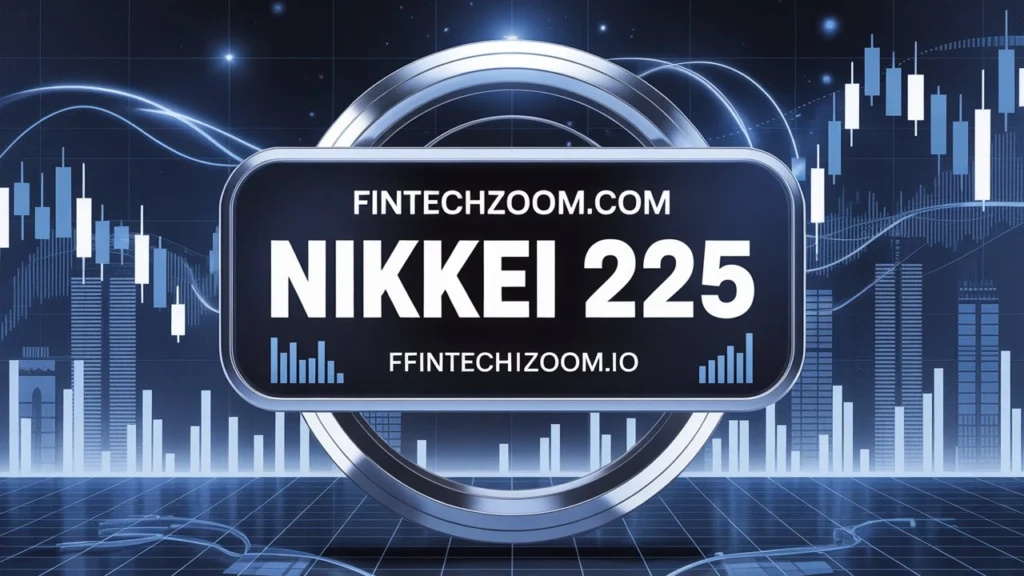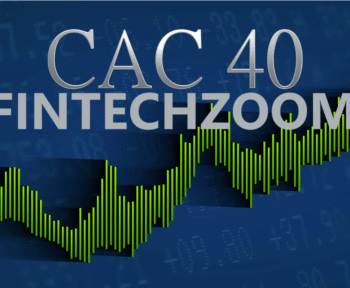The FintechZoom.com Nikkei 225 index represents one of Japan’s leading stock market indices, tracking the performance of 225 major companies listed on the Tokyo Stock Exchange (TSE). But what exactly does this mean for investors, traders, and global financial markets? In this article, we explore the significance of the Nikkei 225 index, its history, its performance, and how FintechZoom.com Nikkei 225 helps investors navigate the complex world of finance.
What is the FintechZoom.com Nikkei 225?
The FintechZoom.com Nikkei 225 is a stock market index that tracks the performance of 225 blue-chip companies in Japan, often seen as a barometer of the country’s economic health. The Nikkei 225 is a price-weighted index, meaning that the companies with the highest stock prices have the largest impact on the index’s movement.
The Nikkei 225 is compiled and published by the Nikkei Inc. and is widely regarded as the most significant stock index in Japan, analogous to the Dow Jones Industrial Average in the United States. It includes major players like Toyota, Sony, and Mitsubishi, and its movements are closely watched by global investors. On FintechZoom.com Nikkei 225, investors can find real-time updates, historical data, and analyses related to the index’s performance.
How Does the FintechZoom.com Nikkei 225 Compare to Other Stock Indices?
When comparing the FintechZoom.com Nikkei 225 with other major global indices like the S&P 500, Dow Jones, or the FTSE 100, it’s important to understand the key differences in methodology. For instance, the S&P 500 is a market-capitalization-weighted index, which means that larger companies with bigger market caps have a more significant influence on the index. In contrast, the FintechZoom.com Nikkei 225 is price-weighted, meaning stock prices rather than company size dictate the index’s movement.
This distinction leads to different volatility patterns and performance comparisons between indices. Investors following FintechZoom.com Nikkei 225 must consider that smaller companies with higher stock prices can influence the index more than larger companies with relatively lower stock prices.
Also Read: Fintechzoom.io: The Ultimate Platform for Stock Market and Crypto Trading
What is the Historical Background of the FintechZoom.com Nikkei 225?
The FintechZoom.com Nikkei 225 has a rich history, originating in 1950. Initially designed as a representation of Japan’s industrial sector, it quickly became a key indicator of the overall performance of the Japanese economy. The index has gone through significant transformations, reflecting the changing dynamics of Japan’s corporate and economic landscape.
For example, in the 1980s, Japan experienced a period of rapid economic expansion. During this time, the Nikkei 225 hit its all-time high of 38,957.44 in December 1989, driven by soaring real estate prices and a booming stock market. However, the bursting of Japan’s economic bubble in the early 1990s caused the index to fall dramatically.
The FintechZoom.com Nikkei 225 has seen various fluctuations over the years, from highs to lows, but it continues to be a critical index for both Japanese and global investors. The rise of technological giants and export-heavy companies like Toyota and Sony helped revitalize the index in the 2000s, and today, it remains one of the most closely monitored financial indicators in Asia.
How is the FintechZoom.com Nikkei 225 Calculated?
The calculation of the FintechZoom.com Nikkei 225 index involves adding the stock prices of the 225 constituent companies and then adjusting for a divisor. This method of calculation, known as a price-weighted index, makes the Nikkei 225 unique compared to market capitalization-weighted indices like the S&P 500.
While market-cap-weighted indices give more weight to companies with larger market values, the FintechZoom.com Nikkei 225 can be heavily influenced by companies with higher share prices. For instance, a stock like Fast Retailing, which is Japan’s largest apparel retailer, has a higher weight in the Nikkei 225 due to its relatively high stock price, despite the company not having the highest market capitalization in Japan.
What Impact Does the FintechZoom.com Nikkei 225 Have on Global Markets?
The FintechZoom.com Nikkei 225 is closely followed by investors and analysts worldwide. Japan is the third-largest economy globally, so the movements of its major stock index can significantly influence global financial markets. When the Nikkei 225 performs well, it can indicate strong economic performance in Japan, which, in turn, can inspire confidence in Asian markets as a whole.
Global investors use the FintechZoom.com Nikkei 225 to gauge the health of Japan’s economy, especially in relation to other Asian economies. For example, if the index experiences a sharp decline due to economic challenges in Japan, it could signal potential trouble for other economies in the region, prompting investors to take action.
Moreover, many international funds and financial institutions incorporate the FintechZoom.com Nikkei 225 into their portfolios as a diversification tool. Its performance can offer insights into the broader economic trends in Asia, making it a critical component for global investment strategies.
How Does the FintechZoom.com Nikkei 225 Reflect Japan’s Economy?
The FintechZoom.com Nikkei 225 serves as a reflection of Japan’s economy due to the fact that it includes 225 of the largest and most influential companies in the country. These companies span various sectors, including automotive, technology, finance, and consumer goods. As such, the movements in the Nikkei 225 can offer insights into the health of Japan’s economy, including growth rates, employment levels, industrial output, and trade performance.
For example, when Japan’s export sector performs well, companies like Toyota and Honda—which are integral to the Nikkei 225—tend to perform better, pushing the index higher. Conversely, any economic slowdowns, whether due to internal challenges or global events, can lead to declines in the FintechZoom.com Nikkei 225, signaling broader economic weakness.
What are the Key Sectors Represented in the FintechZoom.com Nikkei 225?
The FintechZoom.com Nikkei 225 is composed of companies from a variety of sectors, providing a broad representation of Japan’s economic landscape. These sectors include:
- Automotive: Companies like Toyota, Honda, and Nissan dominate this sector, making the automotive industry a key driver of the index’s performance.
- Technology: Japan’s technology sector, including giants like Sony, Panasonic, and SoftBank, has a significant influence on the FintechZoom.com Nikkei 225. These companies are involved in everything from consumer electronics to telecommunications and robotics.
- Finance: Financial institutions like Mitsubishi UFJ Financial Group and Sumitomo Mitsui Trust Bank are major components of the index. The performance of these companies is closely tied to interest rates, government policies, and global market conditions.
- Retail and Consumer Goods: Major players like Fast Retailing (owner of Uniqlo) and Seven & I Holdings (owner of 7-Eleven) represent Japan’s vast retail sector.
- Pharmaceuticals and Healthcare: Companies such as Takeda Pharmaceuticals play a key role in Japan’s healthcare industry and contribute significantly to the index.
The FintechZoom.com Nikkei 225 serves as a snapshot of these diverse sectors, allowing investors to gain insight into the overall health of Japan’s economy.
How Does the FintechZoom.com Nikkei 225 Influence Japanese Monetary Policy?
Japan’s central bank, the Bank of Japan (BoJ), monitors the performance of the FintechZoom.com Nikkei 225 closely as it provides insights into the market’s expectations regarding Japan’s economic outlook. The performance of the Nikkei 225 can impact monetary policy decisions, especially if there are significant downturns that indicate economic stress.
For example, if the Nikkei 225 were to show signs of sustained decline, it could signal to the BoJ that economic conditions are weaker than anticipated, potentially leading to policy adjustments such as lower interest rates or additional quantitative easing measures.
Moreover, the performance of the FintechZoom.com Nikkei 225 can influence public confidence and consumer behavior, both of which are crucial factors in economic performance. Therefore, the BoJ often uses the index as a gauge for broader economic conditions, adjusting policy to stabilize growth and manage inflation.
Can the FintechZoom.com Nikkei 225 be Used as a Benchmark for Investment?
Yes, the FintechZoom.com Nikkei 225 is often used as a benchmark by investors, both in Japan and globally, to measure the performance of their portfolios. Institutional investors, mutual funds, and ETFs that focus on Japan often track the Nikkei 225 as it offers a comprehensive representation of the Japanese stock market.
Additionally, many financial products are linked to the FintechZoom.com Nikkei 225, including index funds and exchange-traded funds (ETFs), which allow investors to gain exposure to the index’s constituent companies without purchasing individual stocks.
How Can Investors Access the FintechZoom.com Nikkei 225 Data?
Investors can access real-time FintechZoom.com Nikkei 225 data through various financial platforms, including websites, apps, and brokerage accounts. Websites like FintechZoom.com provide up-to-the-minute updates on the index, along with detailed charts, news, and analysis to help investors make informed decisions. Additionally, financial institutions, including banks and brokerage firms, often offer data feeds and trading options based on the Nikkei 225.
For those interested in more in-depth analysis, financial news outlets often publish reports and insights on the performance of the FintechZoom.com Nikkei 225, especially during times of volatility or market shifts.
What Are the Major Companies in the FintechZoom.com Nikkei 225?
The FintechZoom.com Nikkei 225 is composed of 225 companies, but certain large-cap stocks tend to dominate the index due to their influence on the Japanese economy. Some of the most significant companies included in the index are:
- Toyota Motor Corporation: As one of the largest automakers in the world, Toyota plays a crucial role in Japan’s economy and the Nikkei 225. The company’s performance is often seen as a reflection of the health of Japan’s manufacturing sector.
- Sony Group Corporation: Known for its consumer electronics, gaming consoles, and entertainment, Sony is a global leader in technology and entertainment. The company’s stock performance significantly influences the FintechZoom.com Nikkei 225.
- SoftBank Group Corporation: This multinational conglomerate and investment company has a significant impact on the index due to its vast portfolio of investments in tech, telecommunications, and other industries.
- Fast Retailing Co., Ltd.: The parent company of Uniqlo, Fast Retailing is a giant in the global retail sector. The company’s performance often mirrors consumer sentiment and retail trends in Japan.
- Mitsubishi UFJ Financial Group, Inc.: As Japan’s largest financial group, its performance has direct implications on the Nikkei 225, especially considering the importance of the financial sector in Japan’s economy.
These companies, along with others in the index, play a central role in shaping the performance of the FintechZoom.com Nikkei 225. Movements in their stock prices can have a disproportionately large impact on the index due to the price-weighted nature of the index.
How Does the FintechZoom.com Nikkei 225 React to Global Events?
The FintechZoom.com Nikkei 225 is not only influenced by domestic events within Japan but also by global developments. As a key economic indicator, its performance is often linked to international factors such as:
- Global Trade Relations: Japan is heavily reliant on exports, so changes in global trade dynamics—especially with China, the U.S., and the European Union—can have a significant effect on the FintechZoom.com Nikkei 225. For example, trade wars or tariffs can reduce the profitability of major Japanese exporters, leading to a decline in the index.
- Currency Movements: The Japanese yen plays a critical role in the performance of the FintechZoom.com Nikkei 225. A stronger yen generally hurts Japan’s exporters by making their goods more expensive abroad, negatively impacting the stock prices of key companies like Toyota and Sony. Conversely, a weaker yen often boosts export-driven profits, leading to positive movements in the index.
- U.S. Federal Reserve Policies: The policies of the U.S. Federal Reserve have a ripple effect on global markets, including the Nikkei 225. For instance, interest rate hikes in the U.S. may lead to capital outflows from Asia, putting downward pressure on the FintechZoom.com Nikkei 225.
- Natural Disasters: Japan is prone to natural disasters such as earthquakes and tsunamis. These events can disrupt supply chains, manufacturing, and exports, resulting in short-term declines in the FintechZoom.com Nikkei 225.
- Global Financial Crises: During periods of global financial instability, such as the 2008 financial crisis, the FintechZoom.com Nikkei 225 often experiences significant declines due to a combination of reduced global demand and investor sentiment.
Given Japan’s interconnectedness with the global economy, investors should closely monitor these and other global events when analyzing the FintechZoom.com Nikkei 225.
What Role Does the FintechZoom.com Nikkei 225 Play in Economic Forecasting?
The FintechZoom.com Nikkei 225 is frequently used as an economic forecasting tool due to its broad representation of Japan’s industrial and technological sectors. The index reflects the collective health of the country’s top corporations, making it an effective barometer for economic trends.
- Leading Indicator: Economists and analysts use the movements of the Nikkei 225 as a leading indicator of broader economic trends in Japan. For instance, if the index is on an upward trajectory, it may indicate strong corporate earnings, consumer spending, and overall economic growth. Conversely, a downturn in the Nikkei 225 can signal economic challenges ahead.
- Inflation Expectations: The performance of the FintechZoom.com Nikkei 225 can also offer clues about inflation expectations in Japan. If the index is performing well despite a weak yen, it might suggest that inflationary pressures are increasing, as companies pass higher costs onto consumers.
- Investment Sentiment: The Nikkei 225 is a gauge of investor sentiment in Japan. A rising index generally suggests optimism about the economy and corporate profitability, while a declining index might indicate investor pessimism, often driven by concerns such as deflation or geopolitical instability.
By closely following the FintechZoom.com Nikkei 225, economists and financial analysts can gain insights into the likely direction of Japan’s economy, providing valuable information for forecasting GDP growth, employment rates, and consumer behavior.
How Do Exchange-Traded Funds (ETFs) Use the FintechZoom.com Nikkei 225?
Exchange-Traded Funds (ETFs) are one of the most popular ways for investors to gain exposure to the FintechZoom.com Nikkei 225. ETFs that track the Nikkei 225 allow investors to buy shares that represent the index as a whole, without needing to purchase individual stocks.
- Nikkei 225 ETFs: There are several ETFs listed on both the Tokyo Stock Exchange and international markets that are designed to replicate the performance of the Nikkei 225. These funds usually invest in the same companies included in the index, making them an efficient way for investors to gain diversified exposure to Japan’s top corporations.
- Global Access to Japanese Market: For international investors, purchasing a FintechZoom.com Nikkei 225 ETF can be a simple and cost-effective way to invest in Japan’s economy. Many of these ETFs are available on global exchanges, such as the New York Stock Exchange or the London Stock Exchange, making them accessible to a wide range of investors.
- Liquidity and Low Fees: ETFs that track the FintechZoom.com Nikkei 225 offer high liquidity, meaning they can be bought and sold quickly on the exchange. Additionally, they often come with lower management fees compared to actively managed funds, which makes them attractive to cost-conscious investors.
- Hedging and Speculation: Some investors use Nikkei 225 ETFs as a tool for hedging against risks in the broader Japanese economy. These ETFs can also be used for speculative trading, especially in short-term market movements.
In short, FintechZoom.com Nikkei 225 ETFs provide an excellent opportunity for investors to gain exposure to the Japanese market without the complexity of selecting individual stocks.
How Can Investors Use the FintechZoom.com Nikkei 225 to Manage Portfolio Risk?
The FintechZoom.com Nikkei 225 can serve as a powerful risk management tool for investors. By understanding the performance of the Nikkei 225 and its correlation with other global indices, investors can make informed decisions to balance risk in their portfolios.
- Diversification: Adding assets linked to the FintechZoom.com Nikkei 225, such as Japanese equities or Nikkei 225 ETFs, can diversify an investment portfolio. Diversification helps to spread risk, as the performance of Japanese assets may not always be correlated with U.S. or European markets. This can be particularly useful during times of global economic uncertainty.
- Market Timing and Hedging: For investors who anticipate a downturn in U.S. markets, they may look to Japanese assets, including those linked to the FintechZoom.com Nikkei 225, as a hedge. Conversely, if investors expect a rise in global demand or technological innovation, they may increase their exposure to the Nikkei 225 to benefit from Japan’s manufacturing and technology sectors.
- Tracking Volatility: Investors can track the volatility of the FintechZoom.com Nikkei 225 to understand the level of risk associated with the Japanese market. By comparing its volatility to other global indices, investors can assess how much exposure to Japan’s economy is suitable for their risk tolerance.
- Economic Cycles: Since the Nikkei 225 reflects Japan’s economic health, it can be used to anticipate the phases of the business cycle. For example, a sustained upward trend in the Nikkei 225 may indicate a period of economic expansion, encouraging investors to allocate more funds into Japanese assets.
Conclusion: The Strategic Importance of the FintechZoom.com Nikkei 225
The FintechZoom.com Nikkei 225 is more than just a stock market index—it’s a critical tool for understanding Japan’s economy, tracking global economic trends, and making strategic investment decisions. Whether you’re an individual investor looking to gain exposure to Japan’s market or a financial institution assessing broader regional impacts, the Nikkei 225 offers essential insights.
With its unique price-weighted structure, historical significance, and deep connection to global economic factors, the FintechZoom.com Nikkei 225 remains a key asset for anyone involved in international finance. By staying updated on the movements of the Nikkei 225, investors can better navigate market conditions, plan for future economic cycles, and ultimately improve their investment strategies.




